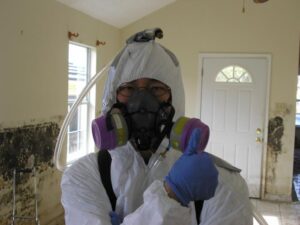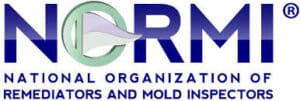A Dozen DOs & DON’Ts for a Healthy Flood Cleanup

To ensure a healthy flood cleanup, identify the tasks you can do yourself and then locate qualified professionals to do the ones you can’t, recommends Doug Hoffman, Executive Director of the National Organization of Remediators and Mold Inspectors and author of Mold-Free Construction. Recognizing if you are in a high-risk health group is the first step in protecting your health when your home, workplace, or school has become water damaged from flooding, explains Kurt and Lee Ann Billings, authors of the bookMOLD: The War Within, which details lessons learned from Katrina.
Many people are completely unaware that their health histories put them in a high-risk category for exposure to structural molds until it is too late and they are already sick, which is exactly what happened to the Billings family. Prevention of health-risking exposures is paramount when in a wet-building environment because the species of mold that grow on it also produce toxic poisons called mycotoxins. By being aware of the following DOs and DON’Ts, flood area residents will be able to make informed, health-focused decisions.
1. Do find out if you or a family member fall into one of the CDC’s high-risk groups for mold, which include but are not limited to the following:
- Infants and children
- Elderly people
- Pregnant women
- People with respiratory conditions, such as allergies or asthma
- People who are immune-compromised or who have weakened immune systems
- People who have undergone recent major surgeries
- People who take immune suppressing medication, including oral or nasal steroids
2. Don’t perform remediation tasks if you fall into one of the CDCs high-risk groups. To best protect your health and property, hire a trained mold professional.
3. Do take the CDCs high-risk group warning seriously. The health of a seemingly 200 lb. strapping young man in his 20s or 30s can become compromised when exposed to mold even if he only has a health history of allergies.
4. Don’t, especially if you fall into one of the CDCs high risk groups, live, work, or go to school—if at all possible—in a structure that has been flooded or suffered water damage until it has been properly remediated and passed final clearance testing.
5. Do wear personal protection equipment (PPE) when entering a mold-contaminated structure for even a short duration of time.
6. Don’t think that personal protection equipment (PPE) is going to be enough to protect you if you are in a high-risk group. Studies show that spores and spore fragments easily penetrate N-95 and N-100 facemasks.
7. Do use a HEPA air purifier to reduce indoor airborne mold spore counts.
8. Don’t use any air purifier as a long-term solution instead of proper remediation.
9. Do use a HEPA air purifier that is sized properly for each room.
10. Don’t expect the HEPA filter to last as long in a mold- and bacteria-contaminated environment as it would under more normal conditions.
11. Do at least create a “clean” sleeping room if a HEPA air purifier can’t be placed in each room.
12. Don’t think that a clean sleeping room is as good a solution as sleeping somewhere else that did not experience water damage.
>Source: National Organization of Remediators and Mold Inspectors (NORMI)
Please contact Aspen Environmental Services for mold testing and removal at (978) 681-5023. Or email[email protected].
Aspen professionals are licensed and insured and members of the National Organization of Remediators and Mold Inspectors (NORMI) and the National Air Duct Cleaners Association (NADCA).



